Toyota Motor Corporation
EVERYONE'S APPROACH CARS
Toyota Motor Corporation is a Japanese automotive manufacturer headquartered in Toyota, Aichi, Japan. In March 2014 the multinational corporation consisted of 338,875 employees worldwide and, as of February 2016, was the 13th-largest company in the world by revenue. Toyota was the largest automobile manufacturer in 2012 ahead of the Volkswagen Group and General Motors. In July of that year, the company reported the production of its 200-millionth vehicle.Toyota is the world's first automobile manufacturer to produce more than 10 million vehicles per year. It did so in 2012 according to OICA, and in 2013 according to company data. As of July 2014, Toyota was the largest listed company in Japan by market capitalization and by revenue.
Toyota is the world's market leader in sales of hybrid electric vehicles, and one of the largest companies to encourage the mass-market adoption of hybrid vehicles across the globe. Cumulative global sales of Toyota and Lexus hybrid passenger car models passed the 9 million milestone in April 2016. Its Prius family is the world's top selling hybrid nameplate with almost 5.7 million units sold worldwide as of 30 April 2016.
On May 8, 2009, Toyota reported a record annual net loss of US $4.2 billion, making it the latest automobile maker to be severely affected by the global financial crisis that started in 2007. Toyota's financial unit had asked for an emergency loan from a state-backed lender on March 16, 2009, with reports putting the figure at more than $3,000,000,000. It said the international financial situation was squeezing its business, forcing it to ask for an emergency loan from the Japan Bank for International Cooperation. This was the first time the state-backed bank has been asked to lend to a Japanese car manufacturer.
In early November 2014, Toyota USA enlisted a recall involving defective inflaters and propellant devices that may deploy improperly in the event of a crash, shooting metal fragments into vehicle occupants. More than 7 million vehicles are potentially affected in the United States. This recall only affects vehicles equipped with Takata airbags released after the year 2000 in North America. The airbags were manufactured by Takata automotive manufacturing. Toyota is offering a free repair to all affected vehicles worldwide.The fault in the Takata air bags also affected other North American automobile manufacturers.

Toyota has factories in most parts of the world, manufacturing or assembling vehicles for local markets in Japan, Australia, India, Srilanka, Canada, Indonesia, Poland, South Africa, Turkey, Colombia, the United Kingdom, the United States, France, Brazil, Portugal, and more recently, Argentina, Czech Republic, Mexico, Malaysia, Thailand, Pakistan, Egypt, China, Vietnam, Venezuela, the Philippines, and Russia.
Official website












































